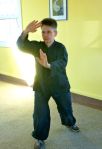Harmonize Inner and Outer
Inner Outer Mutually Harmonize (nei wai xiang he)
Taijiquan trains the shen [spirit]. Therefore it is said, ” the shen is the commander and the body serves as the messenger.” If the shen cane be raised, one’s actions will naturally be light and agile. The outer frame is nothing more than: ’empty, full; open, close.’ What is called ‘opening’ refers not only to the opening of hands and feet; the xin yi (heart; mind, will; intent) simultaneously opens. What is called ‘closing’ means, not only the hands and feet close: the xin yi simultaneously closes. To be able to harmonize inner and outer, thus unifying the qi, this must happen perfectly without gaps. [this is one of Yang Chengfu’s Ten Important Points for the Practice of Taijiquan with original commentary, translated and interpreted by Sam Masich].
Often in the more advanced class, I will invite students to name a focus for the evening’s practice. Tonight we heard breath, breath and movement, moving from post to post, and the one I chose for myself for tonight – Harmonize Inner and Outer. After the practice, we reflected on what the form taught us; what we observed or learned from the focus we had chosen. When I ask my practice a question I usually get either a very straight-forward answer that illuminates a whole world, or I get more questions. Tonight, I got more questions. Harmonize? What exactly is meant by this? Clearly it is different from one must follow the other – inner doesn’t follow outer, or vice versa – as in a previous point about upper and lower. No, harmonize implies an equality of aspects. Inner and outer must get along, somehow – and perfectly without gaps, no less!
Perhaps to harmonize is to unify. Doug Wile’s translation in Tai Chi Touchstones: Yang Family Secret Transmissions is ” The Unity of Internal and External.” He translates the previous point not as Upper and Lower Mutually Follow, but as Unity of the Upper and Lower Body. His consistent use of ‘unity’ seems to slide over some important nuance in the different meanings. But, it is nonetheless helpful to me to consider the notion of unifying as part of understanding harmonizing. Like the yin/yang symbol – the ultimate symbol really of harmony of opposites -contained within a unifying circle. The harmony creates unity.
And that is what I am looking for……ultimately. Unity or harmony of head and heart, spirit and body. I’d like to feel that my insides match my outsides; that if I seem cool and collected, kind and thoughtful on the outside, that I truly feel those things on the inside. Similarly, that if I feel disturbed, or upset on the inside, that I can appropriately express those feelings on the outside. Like everything in tai chi, it is more likely a matter of doing less, than doing anything new and special. Just tune in and stop hindering my expression, and also notice that when all is well ‘out there’ go ahead and just let myself enjoy a little easy all is well in here, too.
Til the next move,


